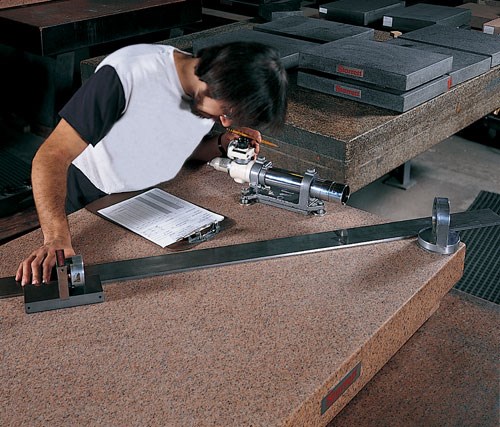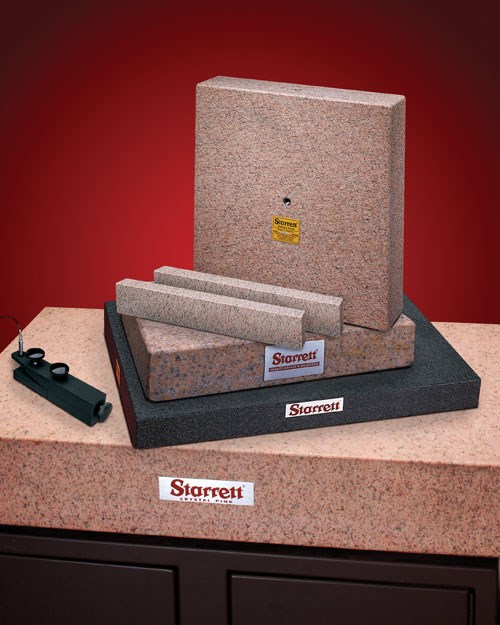Gaging Is Baseless Without Standards
Applying gaging standards consistently is the key to quality parts and products.
#workforcedevelopment
For best gaging practices, manufacturers start with applying primary standards for measurement and inspection that will ultimately lead to consistent, reliable gaging results. Further, they use proper care and maintenance procedures to maintain accuracy and provide long tool life.
The meter is the basis of all measuring systems with the international inch defined as 25.4 mm exactly. Through the years, the meter has been defined in different ways. Currently, the meter equals the distance light travels in a vacuum during 30.663318 cycles of a Cesium atom. Of course, this cannot be used for regular measurement, so the physical relationship is translated by the National Institute of Standards and Technology (NIST) using lasers and atomic clocks and transferred to today’s most basic and accurate precision standard—gage blocks. Gage blocks are the tools that bring this technology to the shop floor where different sizes of blocks may be combined to give any required dimension.
Featured Content
Precision gage blocks are the primary standards vital to dimensional quality control in the manufacture of interchangeable parts. These blocks are used for calibrating precision measuring tools and for setting numerous comparative-type gages used in incoming, production and final inspection areas. Gage blocks provide the most economical, accurate method of setting dial test indicators and other gages used in conjunction with surface plates for inspecting parts with exacting tolerances.
Gage blocks consist of a hard stable material with a flat, parallel gaging surface on each end. The measuring surfaces are ground and lapped to an overall dimension with a tolerance of plus or minus a few millionths of an inch. Gage blocks may be stacked or “wrung” together to form accurate standards of practically any length.
Gage blocks are made in several grades or degrees of accuracy. Grade 0 is the most popular grade of gage blocks, as this grade is usually suitable for most applications and is a grade that offers the best combination of accuracy and cost. Higher accuracy grades of blocks, such as Grade 00, are primarily used as masters to check other gage blocks and for applications that require extreme accuracy. Grade B (± 50 microinches) blocks are relatively inexpensive, but are limited to workshop use where exacting accuracy is not required.
Gage blocks are available in various materials. One example is chrome carbide, which is long-wearing, dimensionally stable and extremely corrosion resistant. These gage blocks will maintain their accuracy many times longer than steel blocks and are available in B89 Grades 00 and 0.
Another material option is ceramic gage blocks, which are long wearing and corrosion resistant. Starrett ceramic gage blocks fill in the gap between steel and chrome carbide and are available in Grades 00 and 0. These blocks have favorable mechanical and thermal properties that compare the closest to steel of any alternative gage block material.
Steel is the most economical gage block material available, and steel’s thermal and mechanical properties are adequate in typical workshop environments. The main disadvantage of steel is its susceptibility to corrosion.
Various styles of gage blocks are available including rectangular, square and Starrett-Webber heavy duty. The use of gage blocks can also be extended by means of accessories that can be used with height gages, snap gages, scribers and dividers.
Even Work Surfaces
Every linear measurement depends on an accurate reference surface from which final dimensions are taken. Precision Granite Surface Plates provide the best reference plane for work inspection and layout prior to machining. They are also especially useful bases for making height measurements and gaging surfaces, parallelism, and so on. A high degree of flatness, stability, overall quality and workmanship also make them especially useful bases for mounting sophisticated mechanical, electronic and optical gaging systems.
The most important element in the performance and life of granite surface plates is the percentage of quartz that is present in the stone. Quartz is more than twice as resistant to wear as the other minerals in granite. It provides bearing points that are of a hard, highly polished, smooth character, which protect the accuracy and finish of both the surface plate and the tools and instruments used on it. Higher quartz content means greater wear resistance. And the longer a surface plate holds its accuracy, the less often it will require resurfacing.
Surface plates without work clamping ledges are recommended for sustained accuracy and reliability. Ledges are for work clamping purposes only. If excessive torque is used when applying clamps to ledges, it can adversely affect measurements taken near the plate edges. If clamping is important, T-slots and threaded metal inserts may also be installed in the surface.
Some applications may warrant customized, special plates. For example, a custom-made plate might be needed for inspecting oversize parts and assemblies such as diesel engine blocks and crankshafts, vehicle frames, missile components and ground support equipment. Or perhaps a special plate or a modification to a standard plate might be required for workholding attachments of many types including threaded inserts, studs, adapter holes, T-slots, dovetails, and so on. The Starrett Tru-Stone Technologies Division specializes in custom granite applications that are especially made for various metrology equipment and other unique precision solutions.
Granite surface plates are manufactured in three grades of accuracy including AA – Laboratory Grade, which is typically specified for precision operations in constant temperature gaging rooms and metrology departments, A – Inspection Grade, which is typically specified for general work in quality control; and B – Toolroom Grade, which is typically specified for production checking work throughout the shop. The final inspection is typically done with an autocollimator in a controlled atmosphere. This instrument is checked and certified against standards traceable to NIST.
Take Care
Since standards are so critical and form the basis for all precision measurement, extra care and regular inspection should be taken to ensure they are accurate.
Gage Blocks: To properly care for gage blocks, wringability is a key test for evaluating the integrity of a gage block’s surface condition. Wringability may be defined as the ability of two surfaces to adhere tightly to each other in the absence of external means, and it is an important property of gage blocks. Blocks that don’t wring may give erratic and unreliable results and are recommended to be replaced.
To prepare gage blocks for wringing together, blocks must be free from nicks and burrs because imperfections on one block may damage the surface of the other block. Blocks may be checked for defects with a gage block stone before wringing. A stone with serrated grooves is recommended because it gives a better “feel” for nicks and burrs that catch the edges of the serrations.
To wring gage blocks, all surfaces must be clean. An oiled wring pad can be used for wiping the surfaces of the blocks. Next, a dry pad can be used to remove as much oil as possible. The blocks should then slide together without any feel or bumps or scratching and should adhere to each other strongly after being rotated into place.
Wringability is an important property of gage blocks, but is fortunately a quality that can be controlled and monitored readily by the user of the blocks. With proper use and care, gage blocks will provide long, reliable, accurate service.
Granite Surface Plates: The granite surface plate is a precision piece of equipment and as such, must be properly installed and maintained. Before use, the plate should always have a reliable support system furnished with the plate. Typically this is a hard rubber pad attached to the bottom of the plate forming a non-distortable three-point support system. The pads are installed during manufacturing, and the plate rests on them throughout lapping, inspection and shipping. They are a critical factor in surface plate accuracy and must not be removed. Plates as large as 6-feet wide by 12-feet long should be furnished with this non-distortable three-point support system. When mounting the plate on a stand, be sure only the pads are resting on the stand. Never support the plate by the ledges or under its four corners, as this will completely void guarantee of accuracy.
Plates larger than 6-feet wide by 12-feet long are supported on multiple support points (six or more points) consisting of granite pedestals and leveling wedges. The number of support points and positioning is determined by the size of the plate. The height of the granite pedestals, or even if they are used, is determined by the thickness of the plate and overall working height desired.
Nylon slings are highly suggested when lifting the granite, and if a forklift must be used to move the granite surface plate, a protective padding should be placed between the metal forks and the granite.
Once set up, plates do not require extensive care and maintenance. Primarily keeping the surface clean and free from buildup of dust, dirt, grease, grime and other foreign particles will maintain accurate tool readings and extend the life of the plate. Environment and usage have much to do with the frequency of cleaning. However, as a rule, it is recommended to clean a plate daily if it is used each day. If the plate is not used for an extended period of time, it should be covered with a surface plate cover.
Workpieces to be measured must be set down gently on the plate, as a sudden jolt or blow to the plate with a heavy metal object can chip or nick the surface. Also, when inspecting workpieces, especially small parts, it is recommended to use different areas of the surface plate because using the same spot over and over, year after year, will wear that area of the plate.
Surface plates should be checked on a regular basis for wear using a repeat reading gage with a manual indicator. Generally, long before a surface plate has worn beyond specifications for overall flatness, it will show worn or wavy spots, which will produce measurement errors. The reading gage will readily detect these error-causing areas.
The gage can simply be set on the plate and zeroed at any point on the table. When the gage is moved over the plate, any hand movements in the indicator more than 0.000025 inch for an “AA” grade plate, 0.000050 inch for an “A” grade plate or 0.000100 inch for a “B” grade plate show that the plate may have some high and low spots and be out of tolerance. Specifically, the tolerance must repeat from side to side within the specified tolerance range in order to be an accurate plate.
RELATED CONTENT
-
Communication: Motivating Employees To Work In The Best Interest Of The Business
Fair treatment is all most employees ask of their employers. Showing both family and non-family employees what is fair and having open lanes of communication allow for a healthy exchange of what constitutes equitable treatment. Effective communication between management and employees on important issues, such as compensation and firm strategy, needs to take place to maintain a motivated and enthusiastic workforce.
-
Low Frequency Vibration Increases Job Shop’s Productivity
With the ability to machine difficult materials more efficiently while improving surface finish, this job shop is reaping the benefits of its Swiss-type lathes that incorporate low frequency vibration.
-
4 Tips for Building an Effective Machining Apprenticeship Program
Developing the right apprenticeship program can be one of the best things a machine shop can do for itself and for the future of manufacturing. Here are key “do’s” and “don’ts” to follow.








